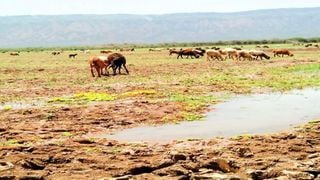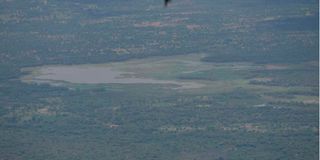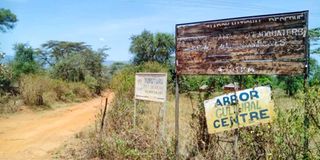
Livestock graze at the Lake Kamnarok Game Reserve in Kerio Valley, Baringo County.
| File | Nation Media GroupBaringo
Premium
Paradox of shrinking Lake Kamnarok as Rift lakes rise
What you need to know:
- When other lakes in the Rift Valley are rising exponentially, the oxbow Kamnarok on the floor of the Kerio Valley is receding at an alarming rate
A paradox of climate change is happening in Baringo.
When other lakes in the Rift Valley are rising exponentially, the oxbow Kamnarok on the floor of the Kerio Valley is receding at an alarming rate, thanks to human activities and degradation that have led to massive siltation, threatening its existence.
Human encroachment in the 87.7-square-kilometre National Reserve has greatly undermined wildlife conservation in the area and neighbouring Rimoi National Reserve, on the border of Baringo and Elgeyo Marakwet counties.
Gazetted as a reserve in 1983, the oxbow lake was once touted as the second-largest ecosystem in Africa with the biggest number of animals after Lake Chad.
With a population of more than 10,000 white crocodiles, 400 elephants, 13 species of other mammals and a variety of birds of rare species, Kamnarok lake boasted one of the richest wildlife reserves in Kenya and the continent.
But that is under serious threat now.
Following a scramble for limited resources with human beings and receding water levels, the animals either perished or fled to the nearby Rimoi reserve in Elgeyo-Marakwet while a big number migrated to South Turkana, dealing a big blow to local tourism.
Locals say all was well until 2010 when the water levels in the lake dropped drastically and it almost dried up in 2013.
When the Nation toured the reserve on Tuesday, we found that it had been turned into a grazing field and what greeted our arrival were thousands of livestock, including cattle, goats and sheep grazing in the open field that used to be the lake.
The only signs that the land was once a lake are traces of aquatic plants, including water lilies locally known as norok, from which the lake derived its name, and a few pools of water.
Walking along the lake, you notice that locals have ploughed to the edge of the drying water body, a situation that has worsened its revival.
No vegetation
There is hardly any vegetation in Kamnarok, contrasting sharply with the nearby neighbouring Rimoi, where it is greener as locals have embraced conservation.
The former world-famous lake is now a shell of its former self as it is almost drying up due to human encroachment and destruction of the environment in the two neighbouring counties.
The degradation has also had a ripple effect in Rimoi, whose wildlife was dependent on the lake for drinking water and grazing, a situation that has led to diminishing feeding habitats, forcing wildlife to scramble for limited resources or migrate elsewhere.
Baringo County Kenya Wildlife Service senior warden Peter Lekeren said if no urgent interventions are made to reclaim the lake, the wildlife would disappear.
Apart from the rare species of crocodiles, the reserve hosts elephants, warthogs, zebras, giraffes and birds.
The reserve was also home to crater kudus, buffalos and rhinos in the early 1970s, but none can be seen now.
Mr Lekeren regretted that because of rampant human activities like wanton cutting down of trees for charcoal and farming activities upstream, the lake in the Kerio Valley of Baringo North sub-county was receding at an alarming rate.
The warden complained that locals graze their thousands of livestock in the reserve, a situation that has completely depleted vegetation, displacing wildlife.
“In the past when the vegetation cover in the reserve was still intact, you could spot dozens of herds of elephants during the day. This has, however, changed because the wildlife has nowhere to graze due to depleted pasture owing to human encroachment,” he said.

A view of Lake Kamnarok in Baringo County.
Elephants gone
Most of the elephants, he said, have migrated to Tot, Mogil and Chesongoch in Marakwet East while others moved to Turkana and Nasolot in West Pokot.
“This has dealt a big blow to wildlife conservation because people have disturbed their habitats, forcing them to move elsewhere. Kamnarok was famous for hosting more than 10,000 white crocodiles and it is now hard to spot them as the few remaining have fled to the Kerio River after the lake almost dried up,” he said.
The phenomenon has also increased human-wildlife conflicts as the animals move out of their habitat in search of vegetation, he said.
“Locals have cultivated over 70 percent of the reserve. You are left wondering how the wildlife inside it would survive. The noises and pollution by tractors ploughing the farms and charcoal burning have also kept the wildlife away because they need a serene environment free of disturbance,” he said.
The reserve, he said, is on the brink of extinction and needs to be fenced off and be restocked with more wildlife.
He appealed to locals to avoid encroaching on water bodies and cultivation upstream.
Depleting pasture
Elgeyo Marakwet KWS warden Zablon Omulako said after depleting pasture in the Kamnarok reserve, farmers have also invaded the Rimoi reserve with thousands of livestock.
Unlike the Kamnarok reserve, the adjacent 66-square-kilometre Rimoi, which is separated by the Kerio River, is fenced off.
In 2016, Tourism CS Najib Balala officially opened it after it was restocked with zebras, giraffes, warthogs and other wildlife.
“Because the two reserves are separated by the Kerio River, locals in the neighbouring Kamnarok have now moved to Rimoi with their thousands of livestock after depleting pasture in the first reserve and the vegetation dried up due to human activities,” he said.
Noting that Rimoi is a much smaller reserve compared with the others, Mr Omulako warned that it might suffer a similar fate as the rest.
“You can imagine tourists who visit the area and instead of seeing wildlife, they are treated to a huge view of cows and sheep. Rimoi was full of live with a lot of wildlife, but they cannot be seen during the day because of human encroachment,” he said.
“Though locals in Elgeyo Marakwet have embraced conservation, their counterparts in neighbouring Baringo County are still adamant, dealing a big blow to tourism.”
He said both reserves host more than 500 elephants but due to encroachment, they migrate during the day and come back to their habitats in the evening.
The Elgeyo Marakwet director of revenue, Philemon Biwott, said human activities in the Rimoi reserve has greatly hampered tourism and led to a drastic reduction in revenue.
Revenues from the reserve declined from Sh1.2 million in 2018 to Sh400,000 in 2021.
“We at one time tried to fine anyone who intruded with livestock into the reserve, but to our dismay, the farmers preferred to pay the fines but continued to bring their livestock for grazing, after they depleted pasture at Kamnarok,” he said.
“It is high time the neighbouring county sensitised their people on the importance of conserving wildlife, otherwise, we will kill the once thriving tourism sector in the two reserves.”
Tree planting
During a tree-planting exercise at Lake Kamnarok recently, Central Rift KWS assistant director Dickson Ritan urged locals to embrace wildlife conservation, noting that it would also boost the economy of the area through tourism.
“If we protect the environment, it will boost the existence of wildlife. Lake Kamnarok is almost drying up due to siltation caused by human activities such as farming and charcoal burning. This has also led to wildlife in the reserve, including the rare species of crocodiles, declining while other animals have migrated,” he said.
“If we conserve the environment, we will reap big from the tourism sector because locals would benefit directly from revenue collected.”
Wildlife corridors have also been affected by human encroachment in the Kerio Valley, he said, sparking human-wildlife conflicts, especially attacks by jumbos.
A row is brewing between more than 7,000 locals living in the Kamnarok reserve, Baringo County government and Kenya Wildlife Service, with locals demanding to be given the findings of a task force formed six years ago to solve a boundary issue in the area.
The Baringo County government created the task force in 2014 bringing together representatives from each of the seven sub-locations in Baringo North sub-county bordering the Kamnarok reserve to look into the reserve’s boundary, which has over the years seen residents clash with KWS.
KWS, the Barwessa MCA, Kenya Forest Service and representatives from the ministries of Tourism and Lands were also part of the team tasked to resolve the stalemate.
The tussles have threatened to derail efforts by the Baringo County government to revive the reserve.
Seven sub-locations in Baringo North sub-county - Muchukwo, Katibel, Keturwo, Konoo, Barwessa, Kaptilomwo and Kuikui - fall inside the reserve.

A sign leading to Lake Kamnarok Game Reserve in Kerio Valley, Baringo County.
Farmers ask questions
But people living near the reserve, who belong to the Kamnarok Farmers Group, have questioned why they were yet to receive the findings of the task force.
The group, led by their chairman Joseph Kiptalla, said their woes started in 1983 when the government gazetted the area as a national wildlife reserve without the consent of locals.
“Some of the locals were part of a task force constituted by the county government in 2014 to solve the boundary issue. We are yet to get the findings of the report six years later, which we suspect were doctored to suit what the government wants. That is why it was not brought back to the public,” he said.
Residents also complained that KWS and the county government have not involved them in the revival efforts and have opposed plans to evict them, adding that the task force should first issue its report.
“The wildlife service has been harassing us over the years to an extent of confiscating our farm equipment when we plough our lands with the pretext that we have encroached into the reserve,” he said.
“Since when did our land become a reserve without our knowledge? As we speak, we do not have food to eat because we have been barred from carrying any farming activity.”
Resident Reuben Chepkong’a complained that locals have been harassed on claims that they are destroying wildlife habitats.
“KWS should also restrain wild animals which have been straying into our farms, damaging our crops and endangering lives,” he said.
Three primary schools - Lake Kamnarok, Cheptigit and Chebukar - with more than 1,000 learners combined are also affected.
Residents are demanding that the county government and KWS spell out clearly how they will be resettled to pave the way for reviving the lake.
Locals living near the reserve have been involved in protracted land tussles over the years with KWS and the defunct Baringo county council.
Both had ordered people living in the reserve to move out or face forcible eviction to allow for the revival of the lake and stock it with more wild animals.
Lots of money spent
In 2015, the Baringo County government in conjunction with KWS had bumped more than Sh40 million into the revival efforts.
In 2018, the devolved unit also spent Sh1.2 million to remove hyacinth that had also choked the lake.
In 2019, three jumbos were stuck for more than six hours in the muddy lake.
Baringo Governor Stanley Kiptis promised that the findings of the task force will be released soon to allow the relocation of the affected locals so as to embark on developing the reserve.
He hoped that the release of the report would be expedited so as projects such as fencing off the reserve and setting up entry and exit gates could start.
“Once we identify the genuine owners, they will be compensated to pave the way for the revival of the lake and stocking of more animals in the reserve,” he said.
“We are also focusing on ensuring that we safeguard the wildlife in Kamnarok, though there have been some concerns from locals bordering the lake who want to be compensated. The findings of the task force created in 2014 to look into the complaints will soon be unveiled so as to put the perennial land tussles to rest.”
But he appealed to locals to avoid invading the reserve and engaging in wanton felling of trees and charcoal burning.
“Destruction of water catchment areas is uncalled for and no one is allowed to encroach into the reserve and start cutting down trees and burning charcoal. Let us all take the responsibility of conserving the environment for our common good,” the governor said.





